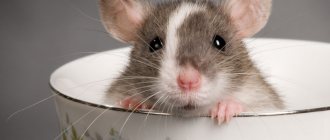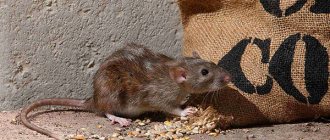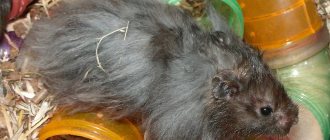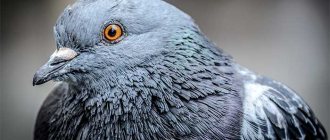Rats' habitat is vast
Rats thrive in most environments where food and shelter are available. Norway rats can be found in homes, warehouses, office buildings, sheds, basements, sewers, landfills and other places that provide ample food. They dig holes in the ground for shelter, nesting and food storage. Burrows usually start next to buildings, fences, or other cover. Black rats do not usually dig burrows; they are found above ground level: in trees, rocks, attics, upper levels of warehouses, wall cavities and roofs.
Rat houses
In nature, gray rats build their home in a hole about 80 cm deep. The length of the corridor reaches several meters. In the very depths, the animals make a nest, insulating it with blades of grass, feathers, and hairs. The common gray rat, living close to the water, in order to avoid flooding during floods, settles in hollows or builds a nest in a tree. Rodents that live near people build nests from all available materials. They can make kubla in things, for example, in a closet that is rarely looked at, in carpets rolled up for storage, in hay that has been folded for storage. In nests, females care for babies, and several broods can be in one place at the same time, and mothers care for the children together.
Rats can squeeze through anywhere
A rat can squeeze through a hole the size of a quarter thanks to its collapsible skeleton. Its ribs are hinged to its spine and can fold up like an umbrella, meaning that any opening large enough for a rat's head is large enough for the rest of its body.
Photo: www, pestologyltd.co.uk
Rats can even chew their way through thick wood, metal pipes, brick walls and cement. Their front teeth are long - they grow about 12-13 cm per year - and also very sharp. To keep their teeth from becoming too long, rats must constantly chew on hard objects and sharpen the edges of their upper and lower teeth against each other, like a knife on a whetstone. The teeth will eventually grow into the brain if rats stop sharpening them.
They are indestructible
This quality unites many movie monsters, especially serial ones: you kill them, you kill them, and by the time the next part comes out they are as good as new again.
Well, what do rats have to do with it, you ask. Common rodents. No hint of immortality. They can be anything they want, but considering them invincible is too much.
However... What is the surest way to kill a rat? I? So here it is. When rats find food they aren't sure is safe, they taste (.pdf) it first—just a little. And if they feel somehow wrong, they don’t touch this food again. They are well aware of our insidious plans and know how to destroy them.
In addition, we are increasingly faced with a completely new variety of these creatures, which scientists have already nicknamed “super mutant rats”, which are no longer affected by practically any poison.
Rats are excellent athletes
The long claws on a rat's paws allow the rodent to scale brick or cement walls with the ease of Spider-Man. Getting down is also not a problem: a rat can fall from a height of 15 meters and land on its paws without injury. They are also phenomenal jumpers: rats can jump up to 60 cm in height from a standing position. According to one study, rats can lift objects that weigh almost 0.5 kg - more than the average body weight of a rodent.
Rats are able to stay in water for three days in a row (in laboratory conditions) and hold their breath under water for up to three minutes. This means they can swim through sewer pipes, squeeze through water pipes, and lick through a hole in a toilet. There are species that can swim more than 1.6 km without resting!
Benefits and harms
It is believed that a small gray rat is capable of leaving a sixth of the world’s population without food (photos of rodents are presented in the article). An adult needs only 20 g of food per day, but over the course of a year this figure increases to 10-12 kg. If you remember that there are now almost 18 billion rats on the planet, you can imagine how much food they eat.
Rats can infect humans with such deadly diseases as plague, Q fever, typhus, as well as non-lethal, but also very dangerous helminths, staphylococci and streptococci.
These animals spoil things, furniture, leave houses and even entire villages without electricity, gnawing through electrical wiring.
And yet they bring us benefits that are difficult to overestimate. Geneticists have found that the genes of humans and gray rats have more in common than those of humans and monkeys. This makes it possible to carry out highly complex genetic research, which is also facilitated by the incredibly fast reproduction of rodents. Scientists are testing new medications on them, studying many deadly diseases in order to understand how to treat us humans. Therefore, rats deserve not only hatred, but also respect.
Rats size XXL
On average, a rat is about 40 cm long (including the tail) and weighs 450 grams. If a rat lives near a permanent food source, such as a trash can, it can grow up to 50 cm in length and weigh 0.9 kg. But this is insignificant compared to the Bosavi woolly rat, which was discovered in 2009 by a BBC expedition on the territory of an extinct volcano in Papua New Guinea. The animal was 81 cm long (including the tail) weighed more than 1.36 kg and showed no fear of people. It is believed to be one of the largest rats in the world. However, don't be afraid to meet it on the street: the rat, which scientists believe belongs to the genus Mallomys, lives only in the area of the volcano.
Photo: www.animals.fandom.com
Unfortunately, scientific research has shown that regular rats are getting larger. On the other hand, researchers believe that physiology will not allow them to turn into giant rats. They will most likely never exceed 1 kg.
History of origin and settlement
Paleontologists have found that the gray rat species appeared in the Pleistocene, that is, approximately 2.5 million years ago. Other rodents, including mice, already existed by that time. The next ice age that began killed many of them, but gave the gray rat the opportunity to establish itself as the most progressive species. In those distant times, these animals lived only in the territory of modern China.
From the south and east their habitat was limited by seas and oceans, from the west by insurmountable mountains, and from the north by a glacier. When it began to melt, the rats moved to new lands. Colonization proceeded unusually slowly. For more than 13 thousand years, they only reached the present-day Transbaikalia, where to this day they live well in natural conditions. Rats were encouraged to spread across the planet by people who began to actively engage in trade and navigation. About 2,000 years ago, tailed stowaways entered India on ships, from there they got to Persia, and then moved to Europe, America, Africa, and Australia. Now they are not found only in places where they have absolutely nothing to eat - in Antarctica, in the Arctic and in certain areas of the desert.
They have very sensitive taste buds
Poisoning a rat is not easy. Animals can detect infinitesimal amounts of poison in food—as little as one part in a million. It's like finding a teaspoon of cocoa in 5,909 liters of milk. Rats are also wary when eating unfamiliar food; they start by tasting a tiny piece of food to make sure that the food is harmless.
Sometimes rats bite sleeping people on the face and hands at night, attracted by food debris on human skin. Once a rat bites a person, the chances of it biting people again increases. It's like finding a new favorite dish and ordering it at every restaurant you visit.
War of blacks and grays
Once upon a time, black rats reigned supreme in Europe. They were known about and destroyed back in the ancient period, and in the Middle Ages they even organized teams of professional rat catchers. Despite all efforts, in the 14th century, millions of people died from a plague carried by black rats.
They are smaller than gray ones, do not like to move long distances and live in basements, preferring to live in attics and roofs. Now in cities the gray rat is replacing the black one, since it turned out to be less intelligent and weaker. If there is enough food, the grays do not bother their black brothers and crowd them out only when there is a shortage of food. In settlements remote from the sea, for example in Moscow, there are very few black rats left, but in coastal cities their numbers are huge, and on ships they still dominate.
The rat has an incredible sense of smell
They have a hypersensitive nose and are especially sensitive to unpleasant odors, which can cause respiratory distress. These small rodents have a nose with 1,207 olfactory receptor genes. They come just behind elephants (1,948 genes) but are far ahead of humans (396 genes) and dogs (811 genes).
Photo: Oxana Kuznetsova
This is likely due to the fact that rats have evolved a sense of smell to be able to sniff out hidden food sources. Rat Nose is so good that it helped clear landmines from Mozambique, and they are now clearing landmines in Cambodia, Zimbabwe and Angola. The rats themselves are too small to detonate the mines, so they are completely safe. The rats simply point out where the explosives are buried so that the mine can be safely detonated.
Ways to control rodents
Let's look at the most effective ways to protect your home and property.
Toxic substances
There are many types of poisons in specialized stores.
All poisons can be divided into strong and weak effects.
- The first category includes zinc phosphide. The poison acts quickly . Once in the stomach, it begins to react with hydrochloric acid and forms hydrogen phosphide, which stops breathing. A 3% concentration of poison is suitable for the death of an animal. It is good because it will not cause poisoning in other animals if they eat a poisoned rat.
- Long-acting substances are more suitable for controlling small rodents. It may take quite some time until the poison accumulates in the body and destroys the animal. In addition, the gray rat’s body is more resistant to poison and can get used to it, so from time to time the type of substance will have to be changed.
What types of poison can be used?
- Treats soaked in poison (grain, cheese, bread, pieces of meat). The method is effective and most common.
- Liquid baits are chemicals dissolved in water and milk.
- Powdered chemicals - for pollinating burrow exits and other places where barn rats might be seen.
- Gaseous chemicals - used, for example, to irrigate burrows. This method should be used with caution, especially in residential areas.
Mechanical traps
Advice! Do not fully charge the mousetrap at first. Let the rodents eat the left baits several times. Rats will get used to taking the left treat and will not suspect that a click will soon occur and the trap will work.
Placing a mousetrap is the easiest way, but not reliable. The barn rat is larger than the vole, so a standard simple mousetrap will not work for it.
In addition, after catching 1-2 rodents, they do not want to go into the mousetrap even with the most exquisite bait.
Ultrasonic repellers
Quite an effective way . Modern devices are effective. Ultrasonic waves negatively affect the psyche of rodents and force them to leave populated areas.
Attention! For good results, the device must work constantly. In addition, when purchasing, it is important to compare the size of the area where the device will be used and the duration of the emitted wave. A universal, standard repeller is suitable for a barn, barn, or home. If you are going to install it on a large area, take care of purchasing several devices.
Path closure
Another not bad way to fight. You can get rid of gray rats in your house or barn by blocking the paths.
Try to figure out the passages, loopholes, paths along which the pasyuk makes its way into the house, and sprinkle calcium chloride . Rodents cannot tolerate this powder.
Rat holes and passages can be covered with cement and crushed glass . It will be extremely difficult for them to gnaw through such a wall.
All methods are good in the fight against the hated gray rodents.
In order for the work to be done effectively, it is better not to settle on any particular method, but try to change them or use them in combination.
Then your home and area will not be afraid of even such unpleasant pests as gray rats.
Rats are very sociable
In the wild, rats tend to live in groups of five, often living in close proximity to other rat families. In areas of low density there is one male per group, which is highly territorial. He is the only mating partner for females. In areas of higher density, males tend to be less territorial, and there may be several males in a group.
These rodents also love human company and may respond to their name. Rats are easy to train. Just like dogs, they will do anything for a tasty treat. They enjoy the interaction they get from doing things like searching, jumping, and coming when called.
The rats laugh, but we don't hear it
Rats make high-pitched chirping sounds (especially when tickled), but humans cannot hear them. Rats communicate at a very high frequency, above 50 kilohertz, so we unfortunately cannot hear their laughter without the help of a bat detection device. Rats especially love to be tickled on the back of their heads. When happy, they chatter or grind their teeth, accompanied by eye twitching. But they will stop laughing when conditions change, such as a bright light or the smell of an approaching cat. Research shows that primates such as bonobos and chimpanzees, dogs and dolphins can also laugh.
Natural enemies
Natural enemies of rats are represented by domestic and wild dogs and cats, ferrets, foxes, pigs, hedgehogs, as well as a wide variety of birds, including owls, owls, eagle, hawks, kites and other relatively large birds of prey. In some countries, rats are eaten.
Return to content
In Novosibirsk there is a monument to laboratory rats and mice
Photo: Irina Gelbukh / Wikimedi
The monument, 1.82 meters high, is located in the courtyard of the Institute of Cytology and Genetics in Novosibirsk. A bronze rodent knitting a DNA double helix, with a small pince-nez on its nose, is installed in memory of the rodents used in laboratory tests. Between 85 and 95% of animals used in laboratories are rodents, including rats, mice, hamsters and gerbils. In the United States alone, 100 million rodents are tested annually.
Rats are known carriers of disease.
They were involved in the spread of about 40 diseases: bubonic plague, typhus, leptospirosis, hemorrhagic fever, salmonella, tapeworm, etc. There are many ways that people or pets can contract the above diseases from rats: rodent bites/scratches, ingestion of contaminated food or water, inhalation of contaminated dust, direct contact with an infected rodent, and bites from infected fleas or ticks.
For many years, rats with plague-infected fleas were thought to have caused the Black Death (1347–1351). The pandemic has killed about 25 million people in Europe, almost a third of the European population. However, recent research suggests that another rodent is to blame for the Black Death: gerbils. The wet conditions of the time caused gerbils, not rats, to flourish. In addition, the distemper virus can be carried by a variety of animals, including cats, dogs, camels, sheep, goats, chipmunks and squirrels. In fact, more than 200 animals are considered carriers of bubonic plague.
Danger to humans
Humanity has been waging its war against rodents for a very long time, and such a fight has even managed to receive a special name - deratization. However, in the east, rats symbolize wisdom and wealth, fertility and prosperity, so the image of rodents in such countries is purely positive. In the western territories, such representatives of the Mouse family are treated with disgust and some caution. To create an extremely negative image, it was enough for people to recall several plague epidemics associated with the carrier of the pathogen - the rat.
This is interesting! Synanthropic rat species cause significant economic damage. Significant losses are the result of eating and spoiling food and non-food products, damage to electrical networks, which causes numerous fires.
Also, some species of rats cause enormous damage to agricultural activities. Rodents often eat crops. As a result, many different methods of control have now been developed and continue to be developed, including repelling and destruction. Rats are currently one of the dangerous natural reservoirs of many anthropozoonotic and zoonotic infections.
Such rodents carry the pathogens of tularemia, plague, rabies, toxoplasmosis, typhoid, leptospirosis, as well as rickettsiosis, sodoku and many other diseases dangerous to humans and domestic animals. Unnoticed by people, representatives of the Mouse family are able to penetrate into the most hidden corners of a human home, using sewer and ventilation passages for this purpose.
It is generally accepted that it is simply impossible to destroy any rodents, including rats, one hundred percent . A quarter of a century ago, the main criteria for deratization were introduced, and the optimal permissible percentage of areas freed from rodents was also designated:
- 80% – the result is satisfactory;
- 90% – the result is good;
- 95% is a very good result.
Thus, the main goal of deratization is to establish and maintain quality indicators of an acceptable level of rodent numbers, at which there will be no complaints from people.
Return to content
They have incredible fertility
When it comes to reproduction, rats leave rabbits far behind. When they are not eating, they usually mate. During one six-hour receptive period, a female rat can mate up to 500 times, which helps explain how a pair of rats can eventually produce 15,000 offspring in one year and why they are the most widespread mammal in the world.
Photo: www.squeaksandnibbles.com
Rats reach reproductive age five weeks after birth, and continue to reproduce until about two years of age. Gestation usually lasts about three weeks, and litter sizes range from 6 to 20 pups. Peak reproduction occurs in spring and autumn.
In China, rats are highly valued.
Rats are considered smart and quick-witted animals, capable of surviving everything that life throws at them - be it earthquakes, famine or war. According to Chinese zodiac legend, when the Jade Emperor invited the animals to a feast, the Rat mounted the Ox and jumped off as soon as they arrived, finishing first. Rats are also considered wealth animals and are revered as symbols of fertility in China. The ancient Egyptians and Mayans also worshiped rats. And people born in the year of the Rat are traditionally considered cunning, witty and wealthy.
How often should deratization be carried out?
Deratization should be carried out as needed, that is, at the first, even indirect, signs of the appearance of rats in the room. Evidence of rodents visiting the site can be their excrement, teeth marks on various surfaces, scattered food, bits of food and other evidence left by the “raiders” at the crime scene. However, according to the law of the Russian Federation, there are a number of social facilities where it is necessary to carry out rat control once a month for preventive purposes in order to eliminate the possibility of rats appearing. Proactive action should be taken in all facilities where food is stored, processed, packaged or prepared. Such objects include:
- Public catering points;
- Enterprises producing or processing products;
- Kindergartens;
- Schools;
- Sanatoriums and holiday homes;
- Hospitals;
- Nursing home;
- Terminals and storage;
- And other similar objects;
Did you know?
- All rats belong to the genus Rattus, which includes 51 species.
- Rats don't sweat. They only have sweat glands on the skin of their paws, which are not sufficient for cooling. To regulate their body temperature, they constrict or dilate the blood vessels in their hairless tails.
- The lifespan of a rat depends on whether it is a wild animal or a domestic animal. Rats kept in captivity can live up to 4 years. In the wild, they typically live 2-3 years. They are hunted by owls, hawks, snakes, dogs, cats and other predators.
- Rats have very poor eyesight. They also suffer from color blindness.
- A rat can go without water longer than a camel. Surprisingly, the kangaroo rat (genus Dipodomys) can spend its entire life in the desert without drinking water. It receives most of the moisture it needs from seeds.
- A rat's heart beats 650 times a minute!
- Cedar and pine oils are toxic to rats and should not be used as bedding.
- Rats were among the first animal astronauts. In 1961, France launched a rocket into space with a rat on board.
- Rats are clean people. Rodents, so often associated with sewers and garbage cans, are actually very clean animals. They spend several hours a day cleaning.
- The Dumbo Rat is a fancy rat with large, round ears that give it a cute teddy bear appearance, making it a very popular pet.
Organizations carrying out pest control
Since rats are a scourge throughout the country, the issue of their destruction is decided at the state level. There is even a law of the Russian Federation obliging the heads of administrations of all settlements and all legal entities to engage in pest control in the territory under their jurisdiction. This does not mean that they themselves must destroy all the rats - their task is to ensure the result by hiring professionals in the field of pest control. The direct performers of this work at the moment are exclusively private companies that provide disinsection, disinfection and deratization services to both individuals and legal entities. In socialist Russia, this function was performed by state sanitary and epidemiological stations, but now they are entrusted only with the tasks of supervision, control and scientific research. Entrusting the direct extermination of rats to private companies was a strategically correct decision - in a competitive environment, each performer strives for quality and gives a guarantee for his work. In addition, small companies are able to quickly resolve all issues without bureaucracy and additional approvals. They themselves purchase drugs, equipment and personal protective equipment, ensure the timely replenishment of all resources for successful and uninterrupted work, which clumsy government structures financed by the state budget cannot boast of. The best companies are always those that have entered this market a long time ago and intend to work in this area seriously and for a long time. They have many years of experience, knowledge and a whole arsenal of necessary means for exterminating rats. A striking example of such a successful company is the SES-24 company.











